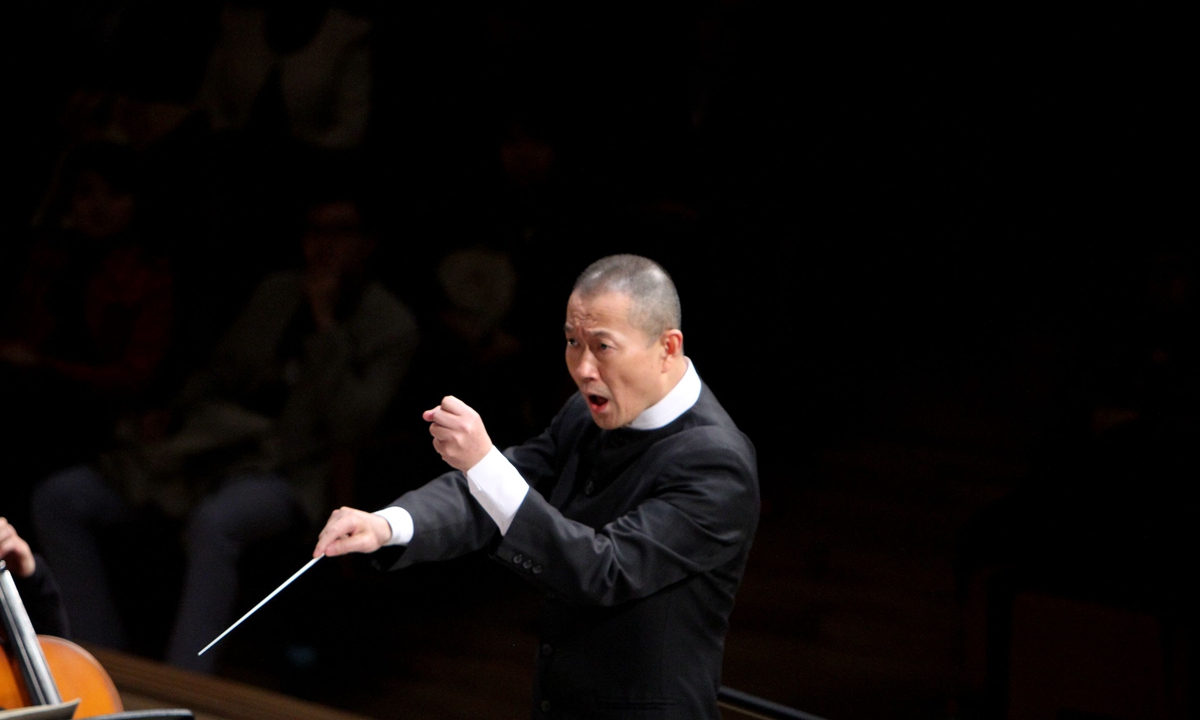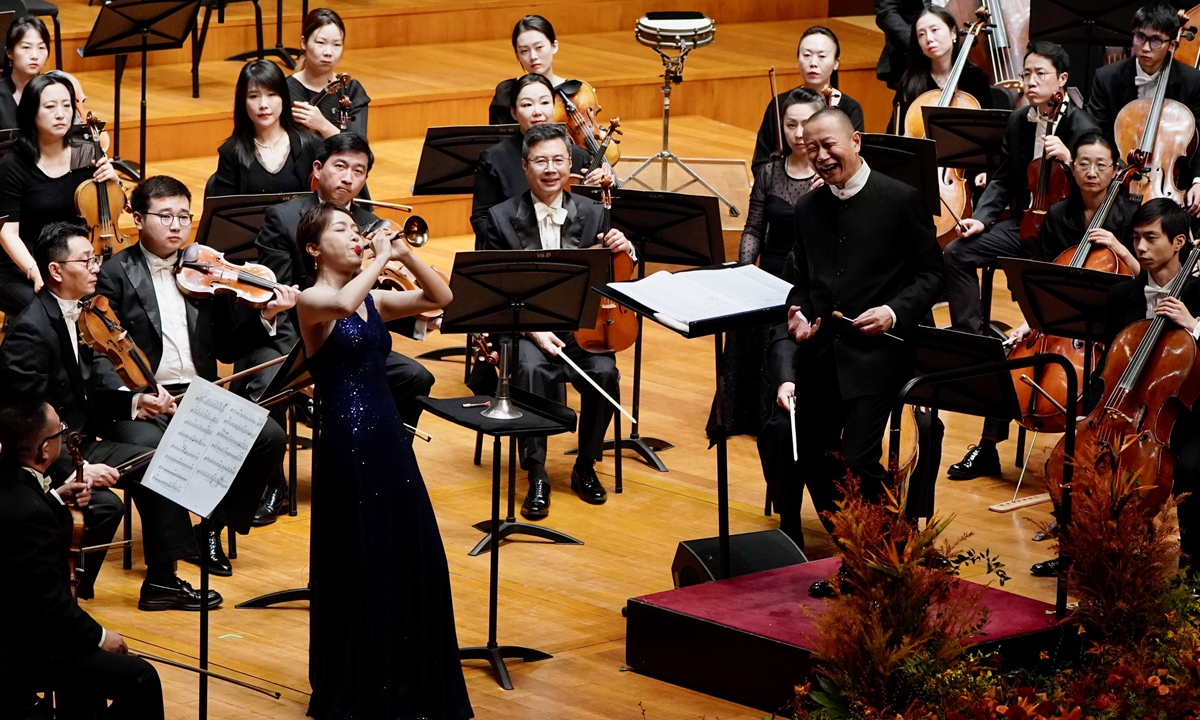
Tan Dun conducts the Guangzhou Symphony Orchestra. Photo: VCG
Editor's Note:
Tan Dun is not a new face at the Beijing Music Festival. The Academy Award and Grammy Award winner for his music score in Ang Lee's Crouching Tiger, Hidden Dragon has been a frequent visitor to one of the biggest classic music fests in China over the past 30 years.
What is new for the 2024 event is the Ancient Bells of Peking's Central Axis composed by Tan, who was inspired by Beijing's Central Axis - the 7.8-kilometer-long north-south line through the capital's historical center that was inscribed on the UNESCO World Heritage List on July 27.
The world-renowned artist has made an indelible mark on the world's music scene with a creative repertoire that spans the boundaries of classical music, multimedia performances and Eastern and Western traditions.
The Global Times talked with Tan about his musical messages to the world and the future, and his belief in the magic of music connecting the world as well as his legendary journey from a village boy standing in the field to a great musician standing in the world's top music halls.

Conducted by Tan Dun, the China National Symphony Orchestra performs the Ancient Bells of Peking's Central Axis in Beijing. Photo: Courtesy of the Beijing Music Festival
At the Beijing Music Festival's opening concert on October 5, Tan led the China National Symphony Orchestra in a performance of his music piece
Passacaglia: Secret of Wind and Birds, during which the orchestra members held up their phones to play recordings of traditional Chinese instruments imitating birds chirping. The traditional Chinese composition
Hundreds of Birds Worshiping the Phoenix and Stravinsky's
The Firebird were also staged. The two are also set to be performed in France in the China National Symphony Orchestra's tour later in October.
"Music is an ambassador to the world and the best language that can be shared by different kinds of people from different cultural backgrounds," Tan told the Global Times.
"The world needs peace, friendship and dialogue now. We are excited to share music and the specific voice of today, the voice of nature, the voice of peace and the voice of friendship."
Linking past and futureLooking for a bridge to link everyone in the world and also link the world's future and the past, Tan decided to turn to the music of birds, from ancient times to the modern era, and further on to the future with cell phones and digital birds.
The birds in the
Hundreds of Birds Worshiping the Phoenix and Stravinsky's
The Firebird have been introduced to "link China's ancient culture about the phoenix and others, as well as Passacaglia."
Chinese national music piece
Hundreds of Birds Worshiping the Phoenix is a masterpiece that often demonstrates the excellent sound of the suona, a loud, high-pitched traditional Chinese musical instrument.
In 2015, the Carnegie Hall commissioned Tan to write a new piece for the National Youth Orchestra of the US's tour of China. With the goal of combining the ancient with the modern,
Passacaglia: Secret of Wind and Birds was born. The piece incorporates recordings of traditional Chinese instruments imitating bird songs played back on the smartphones of the musicians and selected audience members.
Throughout the piece, the orchestra emulates the sounds of birds, the wind, and the ocean. Tan's piece honors both the mankind's desire to communicate with nature and optimism for the future.
"Birds, as Da Vinci said, are a reflection of our future, the mirror of our soul, and the mirror of our today and tomorrow."

Tan Dun plays a "water drum" in Hangzhou, Zhejiang Province. Photo: VCG
'Shaman' of sound To be one of the shamans in his village in Central China's Hunan Province has long been Tan's dream during his childhood.
"They can see all the spirits of life; they can see the wind, talk to the birds, hear stone talking to leaves, and the violin can even talk to the river," he told the Global Times, adding that being a shaman means you can always be treated with a bowl of noodles after each "performance," a great thing for any young boy living in rural areas back then.
The ghost operas that inspired him in some of his works often "have three acts: You welcome the ghost, you entertain the ghost, and you leave with the ghost." In Buddhist terms, it is about "the last life, our present life and the next life." Ghost operas are a mix of Taoism, Buddhism and folk beliefs, which mostly have to do with nature worship; and in the rural area where Tan grew up, they are mediated by people in touch with the spiritual world.
Nature is always part of our symphony as sound and music of these ceremonies always remind Tan of "where I came from."
"I always want to compose for the China National Symphony Orchestra a great field with all kinds of natural sound. Classic music is so absorbing as it bridges the ancient past and the future," said Tan.
His music does emerge from his experiences with nature, from the ghost stories, prayers and village shamans of his youth. One of his most striking pieces, a multimedia event for cello, video and orchestra, called The Map, was actually performed in Xiangxi, or western Hunan Province, where Tan once met a shaman known as "the stone man" who could talk to the wind and the clouds.
When composing folk songs, Tan becomes that village musician, playing on anything he can find: a pot as a drum, even farm tools. His gift for improvisation and making music out of anything at hand is still evident in much of his works. Bowls of water, sheets of rice paper, rocks, stones and anything can be used to express Tan's musical imagination.
"The sound of nature always attracted me to be a musician. Like when I was a child, all those shamans attracted me. I want to be a shaman of the future. I want to be a shaman of sound," he said.
Dialogue with Beethoven In 1973, the Philadelphia Orchestra completed a historic tour performance to China, the first by a US orchestra. The music they played during the trip was heard not just by thousands of audience members in Beijing, but millions of people across the country through radio broadcasts on village loudspeakers.
Among them was a 16-year-old boy working in the rice fields in Hunan Province. One day in 1973, he heard beautiful but strange music filtering across the fields from a loudspeaker - a broadcast of the Philadelphia Orchestra playing in Beijing. The teenager paused in his work as they played Beethoven's Fifth. That boy was Tan Dun.
"The symphony was like a silver light, emitting the sound of the future," recalled Tan, noting that it was the first time he had heard about a "symphony orchestra."
At that time, Tan thought Beethoven as a shaman too, "a foreign shaman." "I didn't know him as a great composer. So I thought the symphony must have a bigger stage than the ghost ceremonies. I must learn it," he said, noting that he made up his mind to learn about the thing called symphony.
Aiming for that, he had to pass the entrance examination of the Central Conservatory of Music, China's best music institute. The competition was fierce, but he was accepted. He said he was always lucky to meet good teachers "who advised him to head in the correct direction and establish clear goals." Tan then flew to New York to further study music. Twenty years after hearing the Philadelphia Orchestra in the field, he received an invitation from the Philadelphia Orchestra itself to join it.
'One home'In September 2024, 200 years after the deaf Beethoven conducted the premiere of his Ninth Symphony, Tan conducted in Bonn, Beethoven's hometown, his commissioned work Choral Concerto: Nine, in which he rediscovers Beethoven's music in the sounds of modern urban life.
He expanded Nine into three movements, respectively titled Nine, Wine, and Time (Ode to Peace), which juxtapose Chinese texts alongside the words of Ode to Joy by Friedrich Schiller.
"These three words, Nine, Wine and Time... in Chinese they are all 'jiu,'" wrote Tan, who also used poetry from two great Chinese poets Qu Yuan and Li Bai.
In Tan's eyes, he is not a great musician at all, but just a farmer.
"The same as Beethoven, who came to the world with the air he breathed and the soil he stood upon, I still remember I came from that village in Hunan, hoping to be a music wizard," he said, noting that what he learned from music masters was no different from what he learned from local shamans in Hunan. Musicians actually have to be loyal to the land they live in.
"A Bing [a blind Chinese musician specializing in the erhu and pipa] is no different from Paganini. For me, the world is one home," as music has the magic to "connect people, the past and the future."
The ancestors of the Chinese today invented many instruments. Behind every instrument, there is a story. If the instruments are forgotten, then the story goes untold and history stops.
"That's why I thought it's always very important to bring ancient instruments to life and play ancient music," said Tan, who once shared the stage with young Chinese suona player Liu Wenwen to play the suona piece
Hundreds of Birds Worshiping the Phoenix in recent tours.
As the nation's first student in the doctoral program of suona at the Shanghai Conservatory of Music, Liu, a 13th-generation suona player, is also one of the most active young players in China.
In Tan's mind, music is like a flowing river and a continuous, ever-evolving force that transcends time. Just as a river never stops moving, music flows from generation to generation, carrying the contributions of countless musicians across eras.
The world is changing, so "we always need to discover new languages to communicate with future young people" and express for them what they want, what they dream and what they hope for.
"The Beijing Music Festival, over nearly 30 years, has carried stories, emotions and historical contexts, acting as a bridge between the past and the present, the East and the West. Many great musicians from around the world perform during the festival. Just like a river connecting different lands and people, the festival connects generations of cultures," Tan says.
After all, it is a stage for sharing music with the world.






